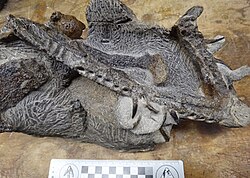
Kagoshima City, is the capital city of Kagoshima Prefecture, Japan. As of 31 July 2024, the city had an estimated population of 583,966 in 285,992 households, and a population density of 1100 persons per km2. The total area of the city is 547.61 km2 (211.43 sq mi).
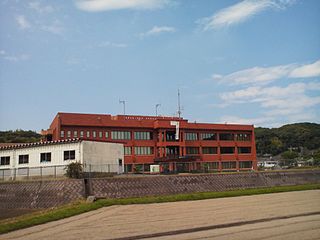
Matsumoto was a town located in Hioki District, Kagoshima Prefecture, Japan.
Iriki was a town located in Satsuma District, Kagoshima Prefecture, Japan.
Miyanojō was a town in Satsuma District, Kagoshima Prefecture, Japan.
Tsuruda was a town in Satsuma District, Kagoshima Prefecture, Japan.

Nagashima is a town located in Izumi District, Kagoshima Prefecture, Japan. As of 31 January 2024, the town had an estimated population of 9618 in 4386 households, and a population density of 83 people per km2. The total area of the town is 116.19 km2 (44.86 sq mi).
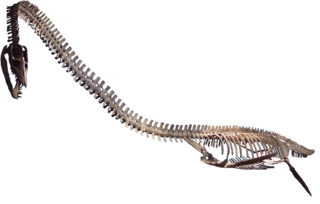
Elasmosaurus is a genus of plesiosaur that lived in North America during the Campanian stage of the Late Cretaceous period, about 80.5 million years ago. The first specimen was discovered in 1867 near Fort Wallace, Kansas, US, and was sent to the American paleontologist Edward Drinker Cope, who named it E. platyurus in 1868. The generic name means "thin-plate reptile", and the specific name means "flat-tailed". Cope originally reconstructed the skeleton of Elasmosaurus with the skull at the end of the tail, an error which was made light of by the paleontologist Othniel Charles Marsh, and became part of their "Bone Wars" rivalry. Only one incomplete Elasmosaurus skeleton is definitely known, consisting of a fragmentary skull, the spine, and the pectoral and pelvic girdles, and a single species is recognized today; other species are now considered invalid or have been moved to other genera.
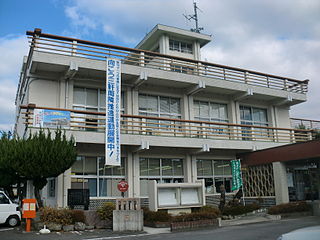
Yūsui is a town located in Aira District, Kagoshima Prefecture, Japan.As of 31 March 2024, the town had an estimated population of 8,361 in 4600 households, and a population density of 58 persons per km2. The total area of the town is 144.29 km2 (55.71 sq mi). "Yūsui" literally means "spring water", referring to springs in the town.

Futabasaurus is a genus of plesiosaur from the Late Cretaceous of Fukushima, Japan. It was described and named in 2006, and was assigned to the family Elasmosauridae. The genus contains one species, F. suzukii.

Mauisaurus is a dubious genus of plesiosaur that lived during the Late Cretaceous period in what is now New Zealand. Numerous specimens have been attributed to this genus in the past, but a 2017 paper restricts Mauisaurus to the lectotype and declares it a nomen dubium.

Scanisaurus is a dubious genus of plesiosaur that lived in what is now Sweden and Russia during the Campanian stage of the Late Cretaceous period. The name Scanisaurus means "Skåne lizard", Skåne being the southernmost province of Sweden, where a majority of the fossils referred to the genus have been recovered. The genus contains one species, S. nazarowi, described in 1911 by Nikolay Bogolyubov as a species of Cimoliasaurus based on a single vertebral centrum discovered near Orenburg, Russia.
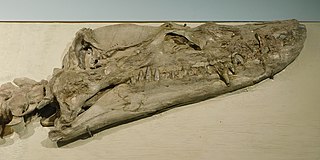
Styxosaurus is a genus of plesiosaur of the family Elasmosauridae. Styxosaurus lived during the Campanian age of the Cretaceous period. Three species are known: S. snowii, S. browni, and S. rezaci.

Aristonectes is an extinct genus of large elasmosaurid plesiosaurs that lived during the Maastrichtian stage of the Late Cretaceous. Two species are known, A. parvidens and A. quiriquinensis, whose fossil remains were discovered in what are now Patagonia and Antarctica. Throughout the 20th century, Aristonectes was a difficult animal for scientists to analyze due to poor fossil preparation, its relationships to other genera were uncertain. After subsequent revisions and discoveries carried out from the beginning of the 21st century, Aristonectes is now recognised as the type genus of the subfamily Aristonectinae, a lineage of elasmosaurids characterized by an enlarged skull and a reduced length of the neck.

Cimoliasaurus was a plesiosaur that lived during the Late Cretaceous (Maastrichtian) of the eastern United States, with fossils known from New Jersey, North Carolina, and Maryland.

Albertonectes is an extinct genus of elasmosaurid plesiosaur known from the Late Cretaceous Bearpaw Formation of Alberta, Canada. It contains a single species, Albertonectes vanderveldei. Albertonectes is the longest elasmosaur, and more generally plesiosaur, known to date both in neck and total body length, estimated around 12 metres (39 ft) long and weighing up to 4.8 metric tons.

This timeline of plesiosaur research is a chronologically ordered list of important fossil discoveries, controversies of interpretation, taxonomic revisions, and cultural portrayals of plesiosaurs, an order of marine reptiles that flourished during the Mesozoic Era. The first scientifically documented plesiosaur fossils were discovered during the early 19th century by Mary Anning. Plesiosaurs were actually discovered and described before dinosaurs. They were also among the first animals to be featured in artistic reconstructions of the ancient world, and therefore among the earliest prehistoric creatures to attract the attention of the lay public. Plesiosaurs were originally thought to be a kind of primitive transitional form between marine life and terrestrial reptiles. However, now plesiosaurs are recognized as highly derived marine reptiles descended from terrestrial ancestors.

Plesioelasmosaurus is an extinct genus of elasmosaurid plesiosaur from the Late Cretaceous Greenhorn Limestone of Kansas, United States. The genus contains a single species, P. walkeri, known from a partial skeleton.
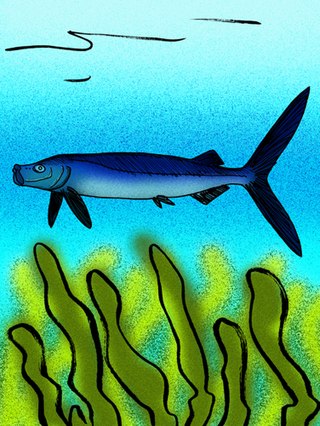
Amakusaichthys is an extinct genus of ichthyodectiform ray-finned fish which lived during the Late Cretaceous, known from only one species A. goshouraensis. Fossils are known from Kumamoto Prefecture in Japan.

Satoshi Utsunomiya is a Japanese fossil collector and science writer. He is an external researcher at the Osaka Museum of Natural History. He is known as the "Salaryman Fossil Hunter".
